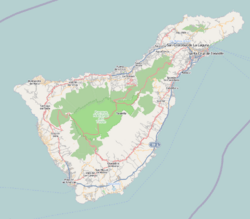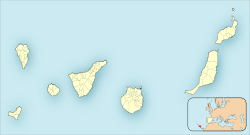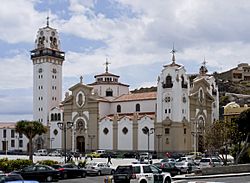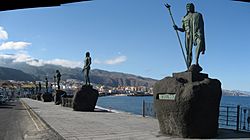Candelaria facts for kids
Quick facts for kids
Candelaria
|
|
|---|---|
|
Municipality
|
|
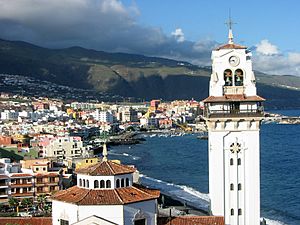 |
|
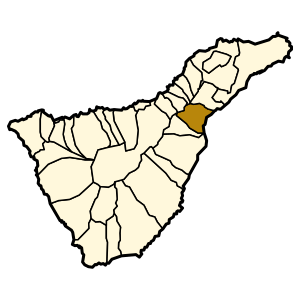
Municipal location in Tenerife
|
|
| Country | |
| Autonomous Community | |
| Province | Santa Cruz de Tenerife |
| Island | Tenerife |
| Area | |
| • Total | 49.18 km2 (18.99 sq mi) |
| Time zone | UTC±0 (WET) |
| • Summer (DST) | UTC+1 (WEST) |
| Post Code |
38530
|
| Climate | BSh |
Candelaria, also known as Villa Mariana de Candelaria, is a city and municipality. It is located on the eastern side of Tenerife island. This island is part of the Canary Islands in Spain. Candelaria is about 17 kilometers southwest of Santa Cruz de Tenerife. In 2010, about 25,140 people lived here. The total area of the municipality is 49.18 square kilometers.
Candelaria is very important to Catholic people. It is a special place where they honor the Virgin of Candelaria. She is considered the patron saint of the Canary Islands. The most famous building in the city is the Basilica of Candelaria. Inside, you can see a sculpture of the Virgin Mary and beautiful paintings. Outside, in the main square, there are statues of the nine ancient kings of Tenerife.
Long ago, when the Guanches lived here, this area was part of the kingdom of Güímar. There are also caves around Candelaria. The city hosts the Festival de la Canción de Candelaria, a big music festival. It celebrated its 10th anniversary in 2005.
Contents
What Does Candelaria Mean?
Before the Spanish arrived, this area was part of the Güímar kingdom. Its original name was simply "Güímar." After the Spanish conquest, the area was renamed "Candelaria." This new name honors the Virgin of Candelaria. She is the patron saint of the archipelago.
Candelaria's Past: A Look at History
The area around Candelaria has many ancient caves. These caves hold burials of the Guanches. Their way of preserving bodies was much like how pharaohs were treated in Egypt.
Around the year 1390, Candelaria was a quiet, empty place. Shepherds from the Güímar kingdom often visited it. One evening, two shepherds saw some goats near a ravine. They found a holy image of the Virgin of Candelaria on a rock. This image later became the main patron saint of the Canary Islands.
The image was first found on a beach near Candelaria. It was then moved to the Cave of Chinguaro. This cave was the palace of the King of Güímar. Later, the Guanches moved the image to Cueva de Achbinico in Candelaria. It has been honored there ever since. The local people thought she looked like their goddess Chaxiraxi. But Christian conquerors said the image was the Virgin Mary. A small chapel was built, and later a large Basilica was constructed for Saint Mary.
Today, Candelaria is the most important Catholic pilgrimage site in the Canary Islands. It is also one of the main ones in Spain.
The current image of the Virgin of Candelaria is dressed in clothes. She is always covered with special robes and jewelry. Interestingly, the Hindu community in the Canary Islands also respects her. They call her the "black virgin." The image is carried in a procession on February 2. This is the day of Candelaria. It is also carried on August 15, the day of the Patron of Canaries. This August date is linked to an old local celebration called Beñesmen. It is believed the Virgin Mary appeared on these dates.
Thousands of people visit Candelaria every year. Many are devoted to the Virgin of Candelaria. Others are tourists who want to explore the culture of the Canary Islands.
Places to Explore in Candelaria
Candelaria has a beach on its eastern side, popular with tourists. The municipality welcomes many pilgrims each year. They come for the annual pilgrimage of Candelaria on February 2 and August 15. The August date is the biggest celebration. The main places to visit are the Basilica of Candelaria and Cueva de Achbinico. But there are other interesting spots too.
Basilica of Candelaria: A Grand Church
The current basilica was built in 1959. It stands where an older chapel once was. When you leave the basilica, you see its tall bell tower. At its base is the Plaza de la Patrona de Canarias. The first large church for the Virgin of Candelaria was built in 1668. This was after her image appeared on Chimisay beach around 1392. As more people visited, a bigger church was needed. The current basilica can hold 5,000 people.
The basilica is on the south side of the city, next to the Atlantic Ocean. Near the Plaza de la Patrona de Canarias, you'll find nine bronze statues. These statues represent the ancient aboriginal kings. Next to the basilica is a Dominican convent. The Dominican religious order takes care of the church. The basilica also has many wall paintings. This church is considered the most important one dedicated to the Virgin Mary in the Canary Islands.
Cueva de Achbinico: The First Church
This cave is also called Cave of San Blas. It was the very first Christian place of worship in the Canary Islands. Here, the original people of the islands honored the Virgin of Candelaria. Scientists found layers of ash in this cave. They used carbon-14 dating to find out the ash is over three thousand years old. A fire was always kept burning in this cave. It was a bit like the temple of the Vestal Virgins in ancient Rome.
Plaza de la Patrona de Canarias: The Main Square
The Plaza de la Patrona de Canarias is a large square in Candelaria. It is right next to the Basilica of Candelaria. This square is a meeting place for pilgrims and for celebrating important festivals. You can also find various cafes and bars here. On one side of the square are the statues of the nine kings. These kings ruled the nine ancient guanches kingdoms of Tenerife.
Calle Obispo Pérez Cáceres: Shopping Street
This is the main shopping street in Candelaria. Here you can find many souvenir shops. There are also stores selling religious items and local crafts. The street runs along the coast. It leads to the Plaza de la Patrona de Canarias and the Basilica of Candelaria.
Iglesia de Santa Ana: Saint Anne's Church
This church is dedicated to Saint Anne. She was the mother of the Virgin Mary. It is the main parish church in Candelaria. The church was built in the mid-1700s. But it stands on the site of a chapel from the 1500s. The church has many religious statues that are very old and artistic.
Fun Festivals in Candelaria
Candelaria hosts several exciting festivals throughout the year:
- Virgin of Candelaria, Liturgical Feast: Celebrated on February 2.
- Saint Blaise: Celebrated on February 3.
- Carnival of Candelaria: Held in February or March each year. It features many lively carnival street bands.
- Festival Intercultural India - Canarias: This is an "Intercultural Festival India - Canary Islands." It takes place on the first Sunday in May.
- Virgin of Carmen and Saint Anne: Celebrated on July 16 and July 26, respectively.
- Festival de la Canción de Candelaria: This is the "Festival of Candelaria Song." It is held in July. This festival has become one of the most important music events on the islands. It had its 10th edition in 2005.
- Virgin of Candelaria, Popular Festival: The main days are August 14 and 15.
Sister Cities of Candelaria
Candelaria has special connections with other cities, called "sister cities":
 Spain Arafo, Tenerife, Spain
Spain Arafo, Tenerife, Spain Spain Güímar, Tenerife, Spain
Spain Güímar, Tenerife, Spain Cuba Candelaria, Cuba
Cuba Candelaria, Cuba Spain Teror, Gran Canaria, Spain
Spain Teror, Gran Canaria, Spain Spain Rota, Cádiz, Spain
Spain Rota, Cádiz, Spain
Images for kids
See also
 In Spanish: Candelaria para niños
In Spanish: Candelaria para niños


